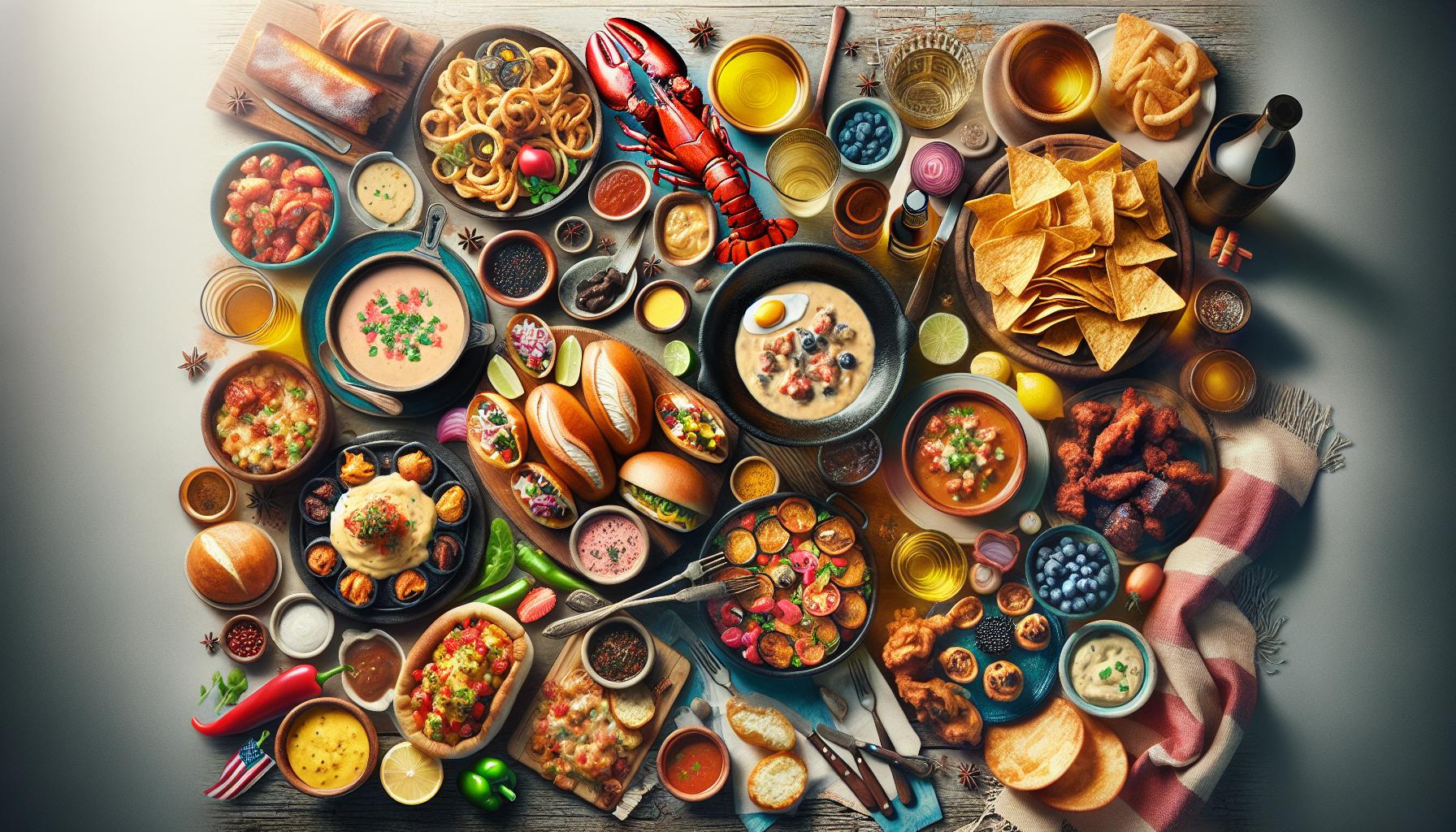Physical Address
304 North Cardinal St.
Dorchester Center, MA 02124

From sizzling burgers to creamy mac and cheese American food culture represents a melting pot of flavors traditions and innovations that reflect the nation’s diverse heritage. It’s more than just fast food joints on every corner – it’s a story of immigration adaptation and the pursuit of the American dream served on a plate.
The evolution of American cuisine mirrors the country’s history with influences from Native American European African and Asian cultures blending to create something uniquely American. Today’s food scene showcases everything from down-home comfort food to trendy fusion dishes making American cuisine one of the most dynamic and exciting culinary landscapes in the world. Whether it’s a backyard BBQ a Thanksgiving feast or a food truck festival American food culture continues to shape how people eat socialize and celebrate across the globe.
Traditional American comfort foods represent nostalgic dishes passed down through generations creating a tapestry of flavors deeply rooted in regional traditions.
Mac and cheese emerged as an American comfort food staple in the 1930s. The dish combines elbow macaroni pasta with a rich cheese sauce made from sharp cheddar blended with milk butter. Kraft introduced the boxed version in 1937 selling over 1 million packages during its first year. Homemade versions feature a crispy breadcrumb topping baked until golden brown. Modern interpretations incorporate specialty cheeses like gruyere gouda fontina creating complex flavor profiles.
Southern fried chicken originated in the American South during the 18th century. The cooking method involves coating chicken pieces in seasoned flour buttermilk then deep-frying until crispy golden brown. Essential seasonings include paprika black pepper garlic powder. The technique creates a crunchy exterior while maintaining juicy tender meat inside. Regional variations add distinctive spice blends ranging from mild to extra spicy heat levels.
Apple pie stands as an iconic American dessert dating back to colonial times. Traditional recipes combine tart cooking apples like Granny Smith with cinnamon nutmeg brown sugar inside a flaky butter crust. Bakers often add signature touches including lattice tops crumb toppings vanilla ice cream. Popular variations include Dutch apple pie featuring a butter streusel topping caramel drizzle. The phrase “as American as apple pie” emerged during World War II reflecting its cultural significance.

America’s diverse regional cuisines reflect distinct cultural identities shaped by local ingredients, historical influences, and immigrant communities. Each region boasts unique flavors and cooking methods that contribute to the nation’s culinary mosaic.
New England’s coastal cuisine centers on fresh seafood harvested from the Atlantic Ocean. Lobster rolls highlight succulent meat dressed in butter or mayonnaise, served in toasted split-top buns. Clam chowder emerges as a regional staple, with Massachusetts favoring creamy white chowder while Maine specializes in clear broth variations. Local specialties include steamed clams, cod cakes, oysters on the half shell from Cape Cod Bay fishing communities dating back to the 1600s. Traditional fish dishes feature cod, haddock, Atlantic salmon prepared through techniques like smoking, steaming, or baking.
Tex-Mex cuisine combines Mexican culinary traditions with Texas cooking styles. Signature dishes incorporate corn tortillas, chili peppers, cumin spices mixed with beef, creating distinctive items like nachos, fajitas, enchiladas. San Antonio’s food scene showcases authentic chile con carne, breakfast tacos, queso dip originating from 1900s border town restaurants. Regional ingredients include poblano peppers, tomatillos, cilantro cultivated in local farms across Texas, New Mexico, Arizona. Creative adaptations feature flour tortillas, yellow cheese, meat-heavy portions reflecting American tastes.
Soul food encompasses African American culinary traditions rooted in rural Southern communities. Cornbread recipes use stone-ground cornmeal mixed with buttermilk, creating crispy crusts in cast-iron skillets. Collard greens simmer with smoked ham hocks, while black-eyed peas represent good luck traditions dating to Civil War era. Fried chicken achieves its signature crispy coating through buttermilk marinades, seasoned flour dredging techniques passed down generations. Classic sides include mac and cheese, candied yams, okra prepared stewed or fried using preservation methods from West African heritage.
American fast food emerged as a cultural phenomenon in the mid-20th century, transforming dining habits across the nation. The combination of automobile culture, mass production techniques and changing social dynamics created a new way of eating that spread globally.
The first drive-through restaurant opened in 1947 at Red’s Giant Hamburg in Springfield, Missouri. Drive-through ordering revolutionized quick-service restaurants by allowing customers to purchase food without leaving their vehicles. The concept gained momentum in the 1950s as car ownership increased exponentially across America. McDonald’s introduced its first drive-through in 1975 in Sierra Vista, Arizona, prompting widespread adoption across the industry. Today, drive-through service accounts for 70% of quick-service restaurant sales in America, generating over $8 billion in annual revenue.
McDonald’s pioneered modern fast-food operations in 1955 with its standardized menu and efficient service model. Burger King launched in 1954, introducing the signature Whopper burger in 1957. Wendy’s entered the market in 1969, distinguishing itself with square patties and fresh ingredients. White Castle, founded in 1921, became America’s first fast-food hamburger chain by selling small, square burgers for 5 cents each. In-N-Out Burger, established in 1948, built a cult following through its “secret menu” and commitment to fresh ingredients. These chains transformed American dining by offering consistent food quality, quick service and affordable prices nationwide.
| Chain | Founding Year | Signature Item |
|---|---|---|
| White Castle | 1921 | Sliders |
| McDonald’s | 1955 | Big Mac |
| Burger King | 1954 | Whopper |
| Wendy’s | 1969 | Square Patties |
| In-N-Out | 1948 | Double-Double |
Immigration waves shaped American cuisine by introducing diverse cooking methods, ingredients, and flavors from around the world. These culinary traditions merged with existing American food culture to create unique dishes that reflect the nation’s multicultural identity.
Italian immigrants introduced pizza to American cities in the late 1800s, transforming it from Neapolitan street food into a national staple. German settlers brought hamburgers, hot dogs, and beer-making traditions, establishing these foods in American culture during the 19th century. Irish immigrants contributed corned beef and cabbage recipes, particularly popular in urban centers like New York City. Polish communities introduced pierogi, which became a staple in the Midwest, especially in cities like Chicago and Pittsburgh. Greek immigrants established diners across America in the early 1900s, popularizing gyros and Greek salads while adapting them to American tastes.
Korean-Mexican fusion emerged in Los Angeles food trucks, creating innovative dishes like bulgogi tacos and kimchi quesadillas. Vietnamese-Cajun seafood boils combine Gulf Coast traditions with Asian spices, gaining popularity across Southern states. Japanese-Peruvian fusion restaurants serve dishes like sushi rolls with tropical fruits and aji amarillo sauce. Chinese-American chefs created dishes like General Tso’s chicken and fortune cookies, adapting traditional recipes for American palates. Indian-inspired pizza toppings feature curry sauce, paneer cheese and tandoori chicken, reflecting contemporary cultural blending. Thai-Italian fusion combines pad thai noodles with Italian pasta techniques, creating unique dinner options.
American food celebrations connect communities through time-honored traditions centered around seasonal gatherings seasonal ingredients. These celebrations showcase the nation’s culinary heritage through specific dishes served at particular times of the year.
Thanksgiving dinner represents America’s most significant food celebration, occurring on the fourth Thursday of November. The traditional feast features a roasted turkey as the centerpiece, accompanied by specific side dishes that vary by region. Common dishes include mashed potatoes with gravy, cranberry sauce, green bean casserole, stuffing made with bread cubes herbs celery. Recent data shows 88% of Americans serve turkey at Thanksgiving, with an average of 46 million turkeys consumed during this holiday. Many families incorporate unique cultural elements into their celebrations, such as adding tamales in Mexican American households or serving macaroni cheese in African American communities.
Fourth of July celebrations emphasize outdoor cooking with grilled meats fresh seasonal produce. Statistics indicate 76% of Americans participate in Independence Day barbecues, cooking an estimated 150 million hot dogs 190 million pounds of beef. Popular grilled items include hamburgers, chicken, corn on the cob watermelon as a cooling side dish. Regional variations add distinct flavors across the country: New England celebrates with clambakes, southern states favor pulled pork, western states embrace tri-tip roasts. Patriotic desserts feature prominently, incorporating red white blue themes through berry trifles, fruit pies decorated cakes.
American food culture continues to evolve with emerging trends that reshape dining habits across the nation. These contemporary movements reflect growing consumer awareness about food sourcing sustainability while embracing innovative dining concepts.
The farm-to-table movement prioritizes locally sourced ingredients directly from producers to restaurants or consumers. Local farmers markets increased from 1,755 in 1994 to over 8,600 in 2023, demonstrating the growing demand for fresh regional produce. Restaurants displaying farm-to-table practices experienced a 30% revenue increase between 2018-2022. Popular farm-to-table establishments focus on seasonal menus featuring ingredients from farms within 100 miles of their location. Leading restaurants like Blue Hill at Stone Barns in New York set industry standards by cultivating their own gardens to supply 80% of their produce needs.
Food trucks transformed urban dining by offering diverse cuisine options at accessible price points. The U.S. food truck industry generates $1.2 billion in annual revenue with over 35,000 active vendors nationwide. Popular food truck hubs include Portland with 500+ registered vendors Seattle with 400+ operators Los Angeles featuring 300+ mobile eateries. These mobile restaurants specialize in fusion cuisine combining traditional flavors with modern twists. Top-performing food trucks earn average daily revenues of $500-$1,500 operating 5-6 days per week. Digital payment systems tech-enabled ordering platforms social media marketing drive 60% of food truck sales.
American food culture stands as a testament to the nation’s dynamic history and diverse population. From traditional comfort foods to modern fusion cuisine the culinary landscape continues to evolve while honoring its roots. Through regional specialties immigrant influences and innovative dining trends American food reflects both its past and its future.
Food remains a powerful force in bringing Americans together whether through holiday feasts backyard barbecues or exploring new culinary frontiers. As American cuisine moves forward it maintains its ability to adapt and grow while preserving the cherished traditions that make it uniquely American.